
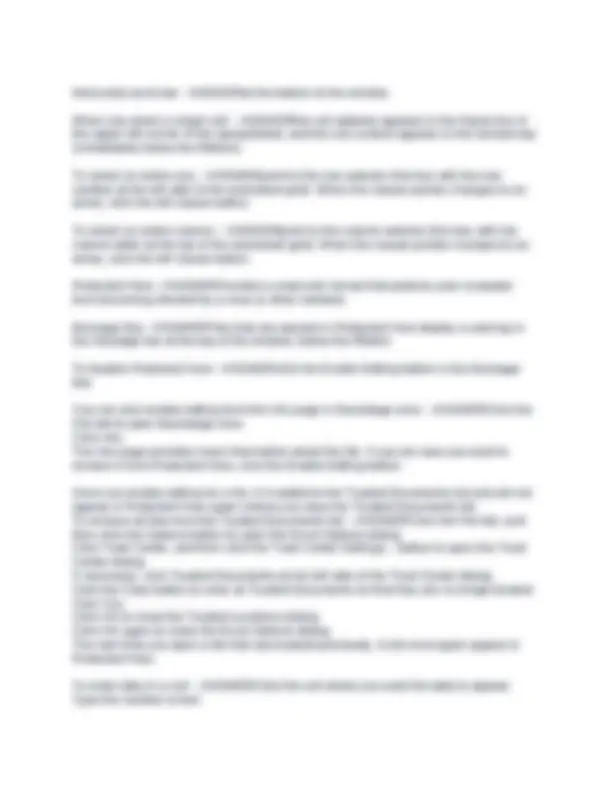
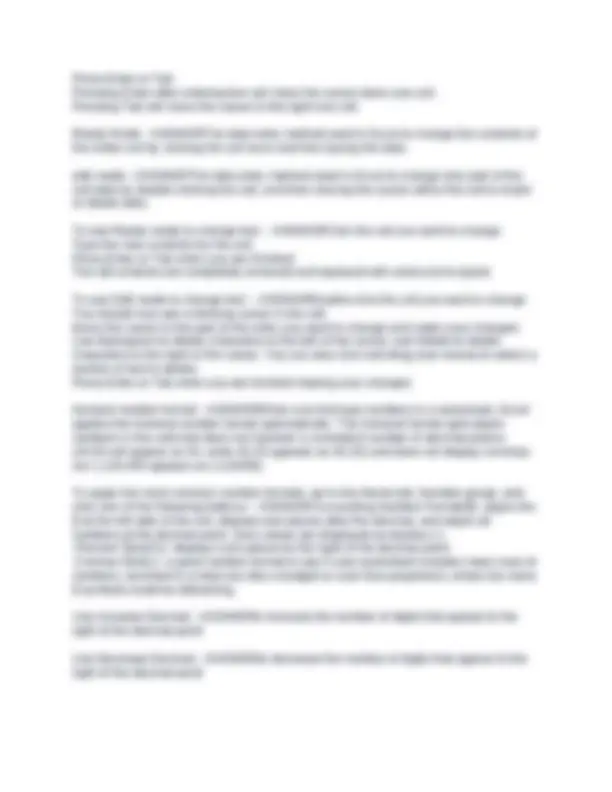
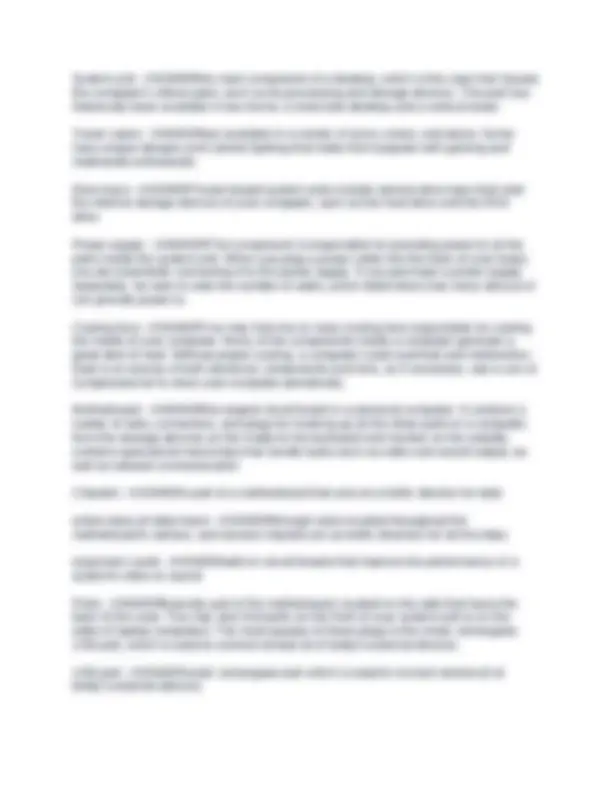
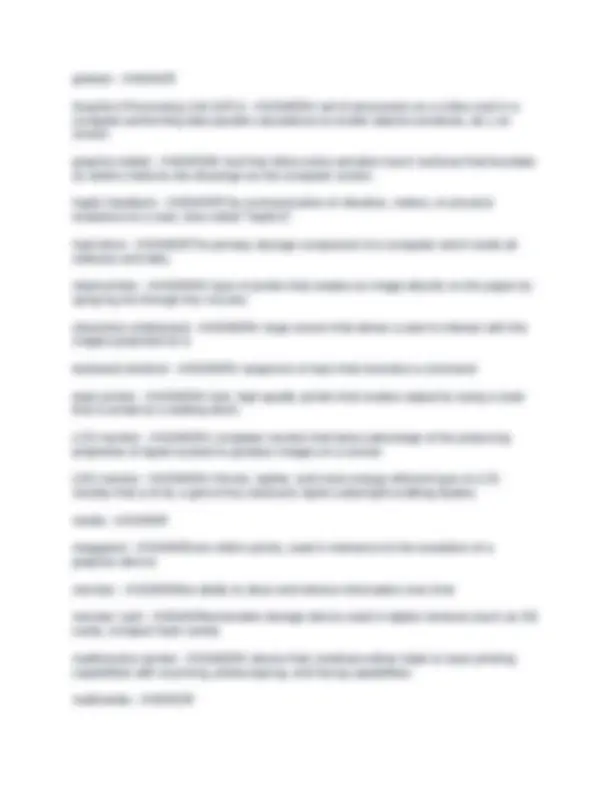
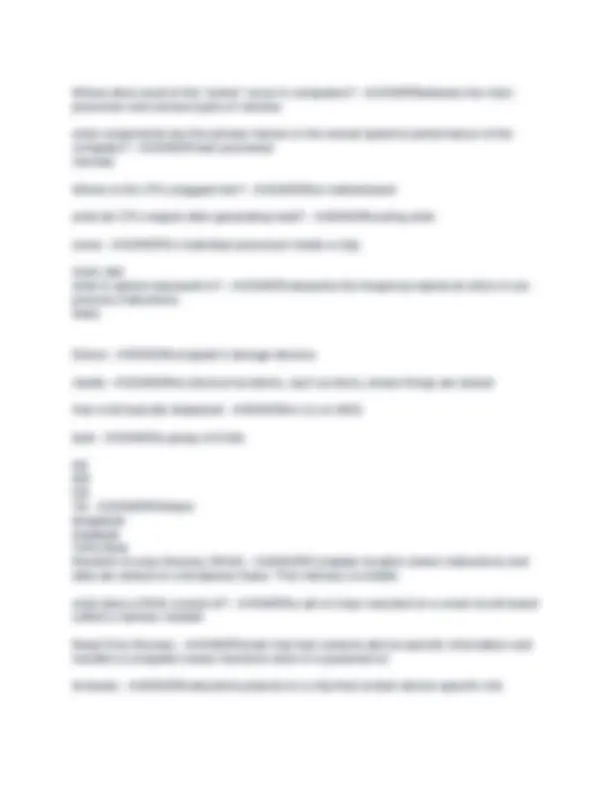
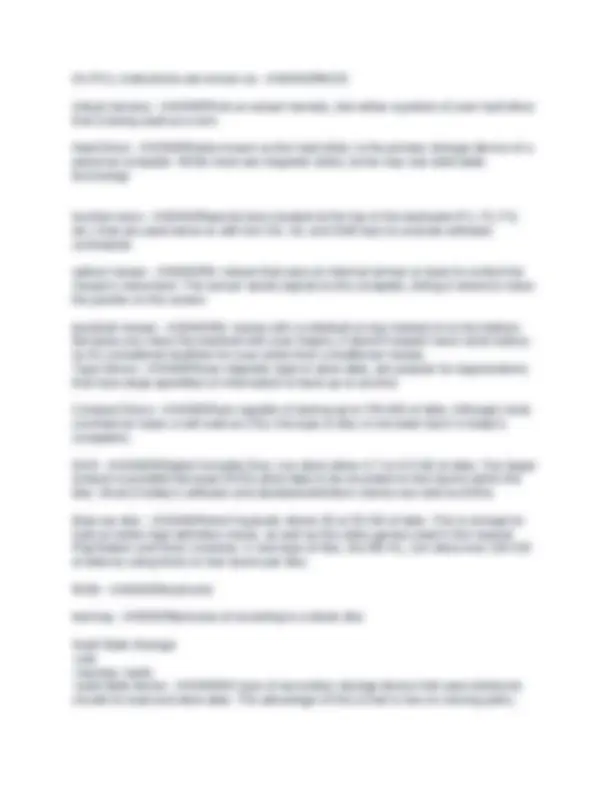


Study with the several resources on Docsity

Earn points by helping other students or get them with a premium plan


Prepare for your exams
Study with the several resources on Docsity

Earn points to download
Earn points by helping other students or get them with a premium plan
Community
Ask the community for help and clear up your study doubts
Discover the best universities in your country according to Docsity users
Free resources
Download our free guides on studying techniques, anxiety management strategies, and thesis advice from Docsity tutors
Microsoft Excel 2016 is - ANSWERa spreadsheet program in which you enter, manipulate, calculate, and chart numerical and text data. Workbook - ANSWERa collection of worksheets. Each worksheet (also called a "sheet") is made up of rows and columns of data on which you can perform calculations. Worksheet - ANSWERan electronic ledger in which you enter data. The worksheet appears as a grid where you can enter and then manipulate data using functions, formulas, and formatting. Excel workbooks have one worksheet by default named Sheet1. You can rename, add, and delete worksheets as necessary.
Typology: Exams
1 / 12

This page cannot be seen from the preview
Don't miss anything!







Microsoft Excel 2016 is - ANSWERa spreadsheet program in which you enter, manipulate, calculate, and chart numerical and text data. Workbook - ANSWERa collection of worksheets. Each worksheet (also called a "sheet") is made up of rows and columns of data on which you can perform calculations. Worksheet - ANSWERan electronic ledger in which you enter data. The worksheet appears as a grid where you can enter and then manipulate data using functions, formulas, and formatting. Excel workbooks have one worksheet by default named Sheet1. You can rename, add, and delete worksheets as necessary. Row - ANSWERa horizontal group of cells. Rows are identified by numbers. For example, the third row is labeled with the number 3. Column - ANSWERa vertical group of cells. Columns are identified by letters. For example, the fourth column is labeled with the letter D. Cell - ANSWERthe intersection of a column and a row. A cell is identified by the cell address — its column and row position. For example, the cell at the intersection of column D and row 3 has a cell address of D3. Cell Range - ANSWERa contiguous group of cells. A cell range is identified by the address of the cell in the upper left corner of the range, followed by a colon, and then the address of the cell in the lower right corner of the range. The cell range B3:B includes cells B3, B4, and B5. A cell range can incorporate multiple columns and rows as long as the cells are all contiguous. The range B3:D5 includes cells B3, B4, B5, C3, C4, C5, D3, D4, and D5. Formula Bar - ANSWERdata entry area directly below the Ribbon and above the worksheet grid. Although you can type any data in the formula bar, the Insert Function button at the left side of the formula bar was designed to make it easier to create complex formulas. Name Box - ANSWERappears at the left side of the formula bar and displays the address of the selected cell. If a group of cells is selected, the Name box displays the address of the first cell in the group. Status Bar - ANSWERappears at the bottom of the worksheet grid and can display information about the selected data, including the number of cells selected that contain data (count) and the average and sum (total) of the selected values. Vertical Scroll bar - ANSWERat the right side of the window
Press Enter or Tab. Pressing Enter after entering text will move the cursor down one cell. Pressing Tab will move the cursor to the right one cell. Ready Mode - ANSWERThe data entry method used in Excel to change the contents of the entire cell by clicking the cell once and then typing the data. edit mode - ANSWERThe data entry method used in Excel to change only part of the cell data by double-clicking the cell, and then moving the cursor within the cell to insert or delete data. To use Ready mode to change text: - ANSWERClick the cell you want to change. Type the new contents for the cell. Press Enter or Tab when you are finished. The old contents are completely removed and replaced with what you've typed. To use Edit mode to change text: - ANSWERDouble-click the cell you want to change. You should now see a blinking cursor in the cell. Move the cursor to the part of the entry you want to change and make your changes. Use Backspace to delete characters to the left of the cursor, use Delete to delete characters to the right of the cursor. You can also click and drag your mouse to select a section of text to delete. Press Enter or Tab when you are finished making your changes. General number format - ANSWERWhen you first type numbers in a worksheet, Excel applies the General number format automatically. The General format right-aligns numbers in the cells but does not maintain a consistent number of decimal places (43.00 will appear as 43, while 42.25 appears as 42.25) and does not display commas (so 1,123,456 appears as 1123456). To apply the most common number formats, go to the Home tab, Number group, and click one of the following buttons: - ANSWER-Accounting Number Format($): aligns the $ at the left side of the cell, displays two places after the decimal, and aligns all numbers at the decimal point. Zero values are displayed as dashes (-). -Percent Style(%): displays zero places to the right of the decimal point. -Comma Style(,): a good number format to use if your worksheet includes many rows of numbers, summed in a total row (like a budget or cash flow projection), where too many $ symbols could be distracting. Use Increase Decimal - ANSWERto increase the number of digits that appear to the right of the decimal point Use Decrease Decimal - ANSWERto decrease the number of digits that appear to the right of the decimal point
System unit - ANSWERthe main component of a desktop, which is the case that houses the computer's critical parts, such as its processing and storage devices. This part has historically been available in two forms: a horizontal desktop and a vertical tower. Tower cases - ANSWERare available in a variety of sizes, colors, and styles. Some have unique designs and colorful lighting that make them popular with gaming and multimedia enthusiasts. Drive bays - ANSWERTower-based system units include several drive bays that hold the internal storage devices of your computer, such as the hard drive and the DVD drive. Power supply - ANSWERThis component is responsible for providing power to all the parts inside the system unit. When you plug a power cable into the back of your tower, you are essentially connecting it to the power supply. If you purchase a power supply separately, be sure to note the number of watts, which determines how many devices it can provide power to. Cooling fans - ANSWERYou may find one or more cooling fans responsible for cooling the inside of your computer. Many of the components inside a computer generate a great deal of heat. Without proper cooling, a computer could overheat and malfunction. Dust is an enemy of both electronic components and fans, so if necessary, use a can of compressed air to clean your computer periodically. Motherboard - ANSWERthe largest circuit board in a personal computer. It contains a variety of slots, connectors, and plugs for hooking up all the other parts of a computer, from the storage devices on the inside to the keyboard and monitor on the outside; contains specialized microchips that handle tasks such as video and sound output, as well as network communication. Chipsets - ANSWERa part of a motherboard that acts as a traffic director for data where does all data travel - ANSWERthrough wires located throughout the motherboard's surface, and several chipsets act as traffic directors for all this data. expansion cards - ANSWERadd on circuit boards that improve the performance of a system's video or sound. Ports - ANSWERtypically part of the motherboard, located on the side that faces the back of the case. You may also find ports on the front of your system unit or on the sides of laptop computers. The most popular of these plugs is the small, rectangular USB port, which is used to connect almost all of today's external devices. USB port - ANSWERsmall, rectangular port which is used to connect almost all of today's external devices.
digital camera - ANSWERPortable devices that electronically capture and store still images and video. digital projector - ANSWERA device that projects digital images and video onto a large screen where they can be viewed by an audience. digital versatile disc (DVD) - ANSWERA type of optical storage technology that is capable of storing 4.7 or 8.5 GB of data. digital video recorder (DVR) - ANSWERA device that allows you to record television shows for future playback document feeder - ANSWERA tray that allows you to scan several sheets of paper automatically. dot matrix printer - ANSWERA printer that creates characters and graphics by striking an inked ribbon with small wires called pins, generating a fine pattern of dots. dots per inch (DPI) - ANSWERA measurement of image quality for printers. drive - ANSWERA computer's storage devices. duplexing - ANSWERThe ability to automatically print to both sides of a piece of paper. dye-sublimation printer - ANSWERA printer that uses a process where colored dyes are heated and then diffuse on specialty paper or other materials. ergonomic keyboard - ANSWERA keyboard that places the keys at angles that allow your wrists to assume a more natural position while you type, potentially reducing the risk of repetitive-stress injuries. expansion card - ANSWERAdd-on circuit boards that improve the performance of a system"s video or sound. facial recognition - ANSWERA biometric technology that looks for unique measurements in an individual's face. fingerprint scanner - ANSWERA biometric technology that can detect the unique patterns and swirls of an individual's finger. Firmware - ANSWERInstructions placed on a chip that contain device- specific information. game controller - ANSWERAn input device used to play computerized games; examples include joysticks and game pads.
gesture - ANSWER Graphics Processing Unit (GPU) - ANSWERA set of processors on a video card in a computer performing data parallel calculations to render objects (windows, etc.) on screen. graphics tablet - ANSWERA tool that offers extra-sensitive touch surfaces that translate an artist's motions into drawings on the computer screen. haptic feedback - ANSWERThe communication of vibration, motion, or physical resistance to a user; also called "haptics". hard drive - ANSWERThe primary storage component of a computer which holds all software and data. inkjet printer - ANSWERA type of printer that creates an image directly on the paper by spraying ink through tiny nozzles. interactive whiteboard - ANSWERA large screen that allows a user to interact with the images projected on it. keyboard shortcut - ANSWERA sequence of keys that executes a command laser printer - ANSWERA fast, high-quality printer that creates output by using a laser that is aimed at a rotating drum. LCD monitor - ANSWERA computer monitor that takes advantage of the polarizing properties of liquid crystals to produce images on a screen LED monitor - ANSWERA thinner, lighter, and more energy-efficient type of LCD monitor that is lit by a grid of tiny electronic lights called light emitting diodes. media - ANSWER megapixel - ANSWERone million pixels, used in reference to the resolution of a graphics device memory - ANSWERthe ability to store and retrieve information over time memory card - ANSWERremovable storage device used in digital cameras (such as SD cards, compact flash cards) multifunction printer - ANSWERA device that combines either inkjet or laser printing capabilities with scanning, photocopying, and faxing capabilities. multimedia - ANSWER
On PCs, instructions are known as - ANSWERBIOS virtual memory - ANSWERnot an actual memory, but rather a portion of your hard drive that is being used as a ram Hard Drive - ANSWER(also known as the hard disk), is the primary storage device of a personal computer. While most use magnetic disks, some may use solid state technology function keys - ANSWERspecial keys located at the top of the keyboard (F1, F2, F3, etc.) that are used alone or with the Ctrl, Alt, and Shift keys to execute software commands optical mouse - ANSWERA mouse that uses an internal sensor or laser to control the mouse's movement. The sensor sends signals to the computer, telling it where to move the pointer on the screen. trackball mouse - ANSWERA mouse with a rollerball on top instead of on the bottom. Because you move the trackball with your fingers, it doesn't require much wrist motion, so it's considered healthier for your wrists than a traditional mouse. Tape Drives - ANSWERuse magnetic tape to store data, are popular for organizations that have large quantities of information to back up or archive. Compact Discs - ANSWERare capable of storing up to 700 MB of data. Although most commercial music is still sold as CDs, this type of disc is not used much in today's computers. DVD - ANSWERDigital Versatile Disc; can store either 4.7 or 8.5 GB of data. The larger amount is possible because DVDs allow data to be recorded on two layers within the disc. Most of today's software and standard-definition movies are sold as DVDs. Blue-ray disc - ANSWERwhich typically stores 25 or 50 GB of data. This is enough to hold an entire high-definition movie, as well as the video games used in the newest PlayStation and Xbox consoles. A new type of disc, the BD-XL, can store over 100 GB of data by using three or four layers per disc. ROM - ANSWERread only burning - ANSWERprocess of recording to a blank disc Solid State Storage -usb -memory cards -solid state drives - ANSWERA type of secondary storage device that uses electronic circuits to read and store data. The advantage of this is that is has no moving parts,
making it faster and less likely to be damaged if dropped. Also called flash memory. (Compare magnetic storage with optical storage and solid state storage) Alphanumeric Keys - ANSWERThese refer to the main set of keys that allow you to input letters, numbers, and punctuation. The most common arrangement of these keys is referred to as the QWERTY (pronounced KWER-tee) layout because of the first six letters near the top left. what are 2 important hardware devices the determine the quality of an image displayed onscreen? - ANSWER-monitor -video controller pixels - ANSWERA monitor's screen is divided into a matrix of small dots. resolution - ANSWER# of pixels that the monitor can display on the screen Optical Character Recognition (OCR) - ANSWERthe capability of specialized software to interpret the actual letters and numbers on a page to create a digital document that can be edited, rather than a flat picture RFID tag - ANSWERan electronic identification device that is made up of a chip and antenna TV tuner - ANSWERA device that can capture television signals for viewing on a computer. Some ppl use tv tuners as - ANSWERDVR (digital video recorder) to record television shows for future playback. biometrics - ANSWERmeasurement of patterns/characteristics found in the human body monitor - ANSWERan electronic display device, or screen, used to output text and graphics to the user. response time - ANSWERthe amount of time it takes for a pixel to change from black to white; lower values are ideal for smooth display of fast-moving images larger value of contrast ratio? - ANSWERproduces higher quality pictures Viewing angle - ANSWERMeasured in degrees, this is the maximum angle at which a monitor can be viewed before the image equality degrades to unacceptable levels. CRT monitors - ANSWERRarely used today, these large and bulky displays used cathode-ray tube (CRT) technology. LCD (liquid crystal display) monitor - ANSWERcontains a light source and a screen of special crystals placed in the monitor between the user and the light source.